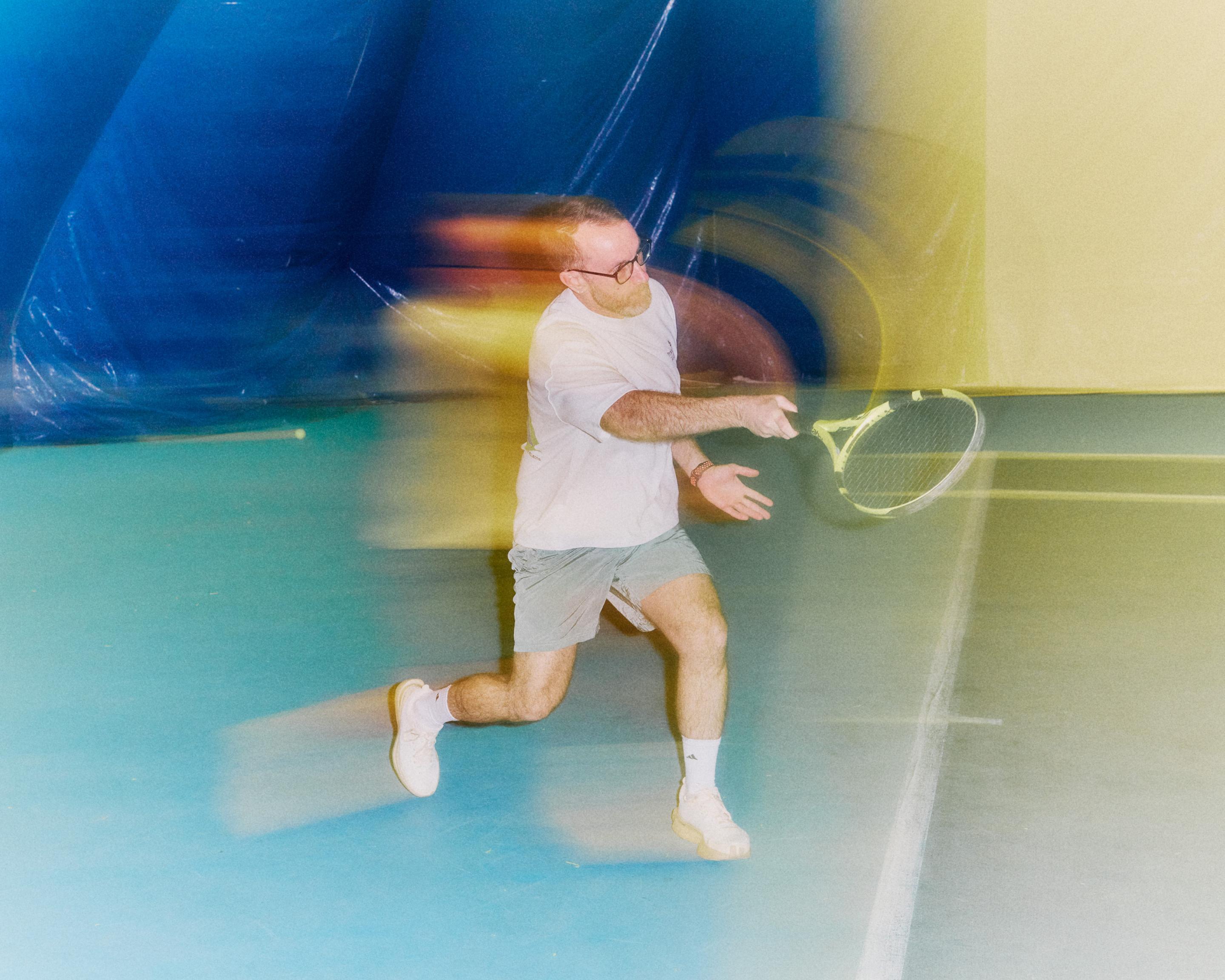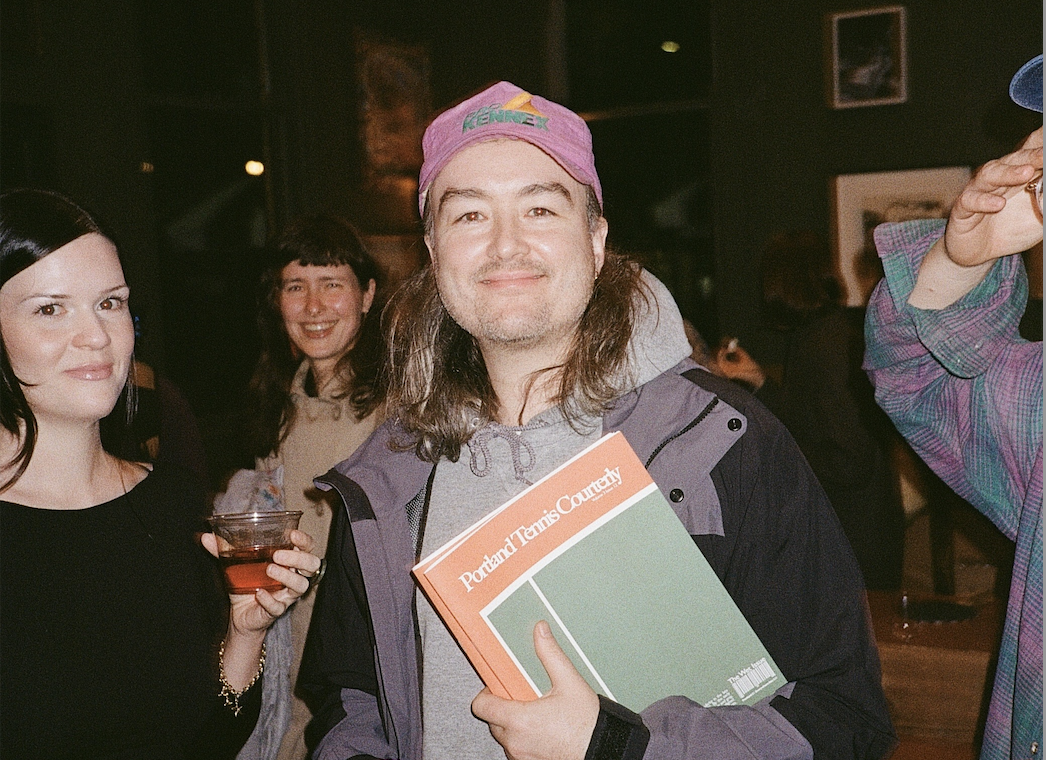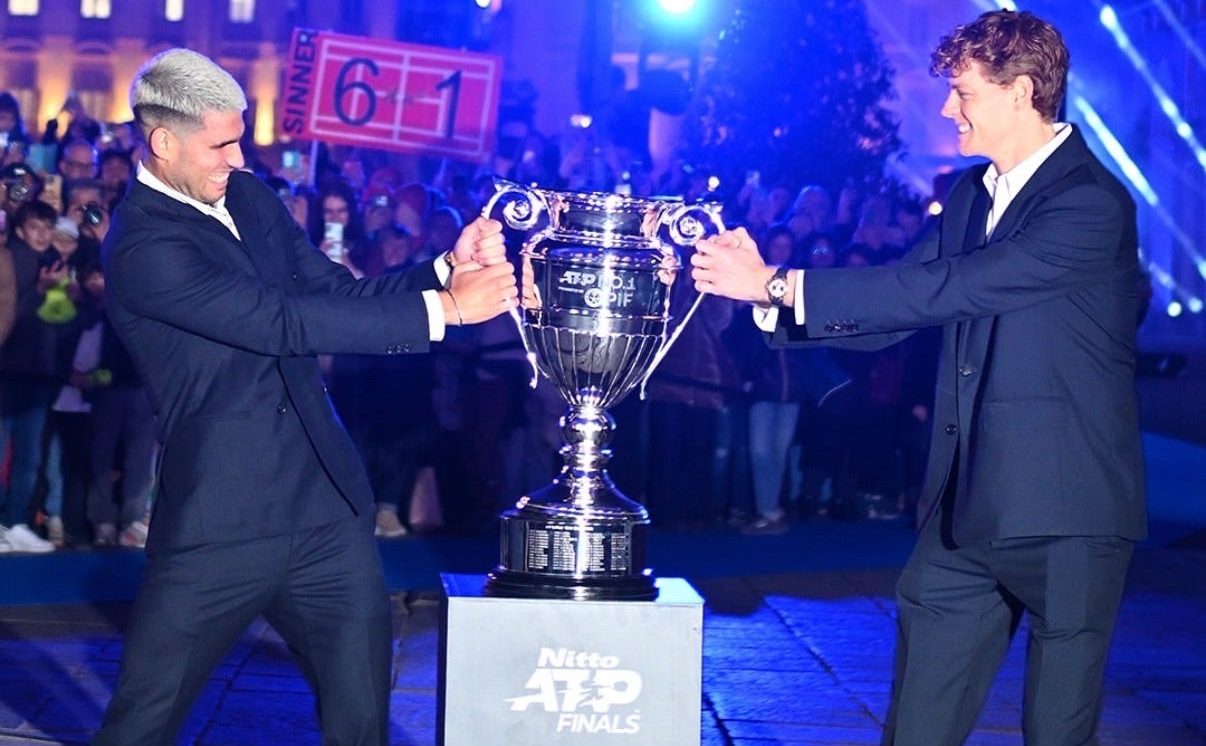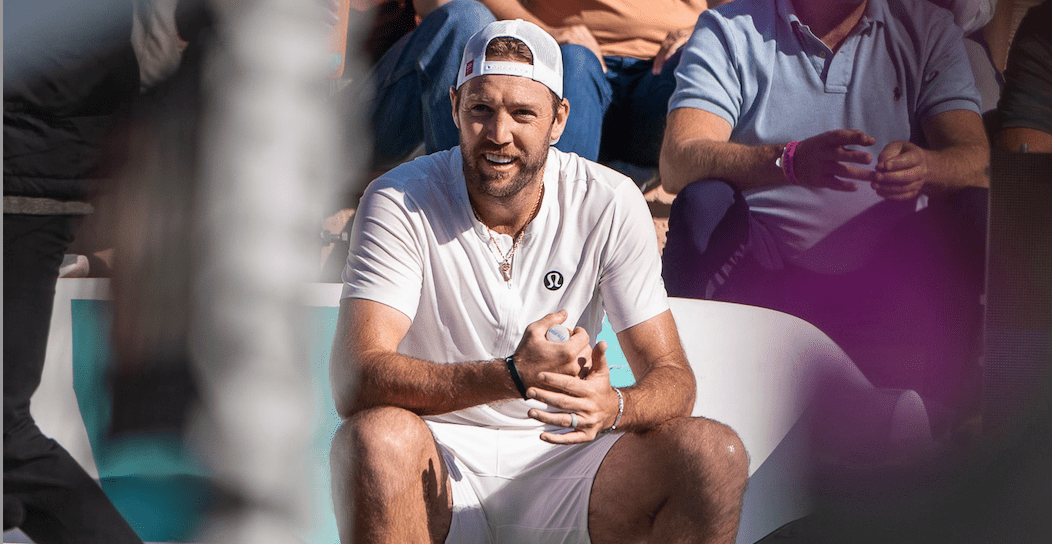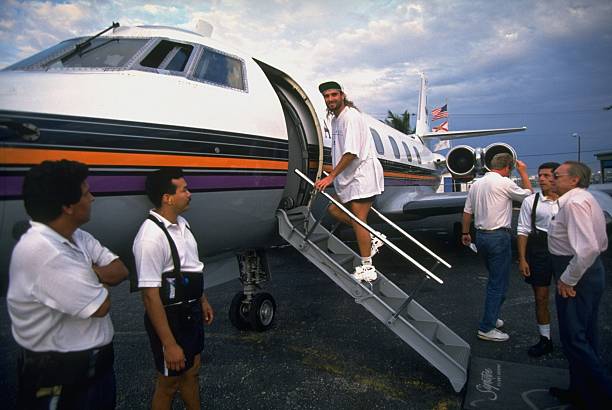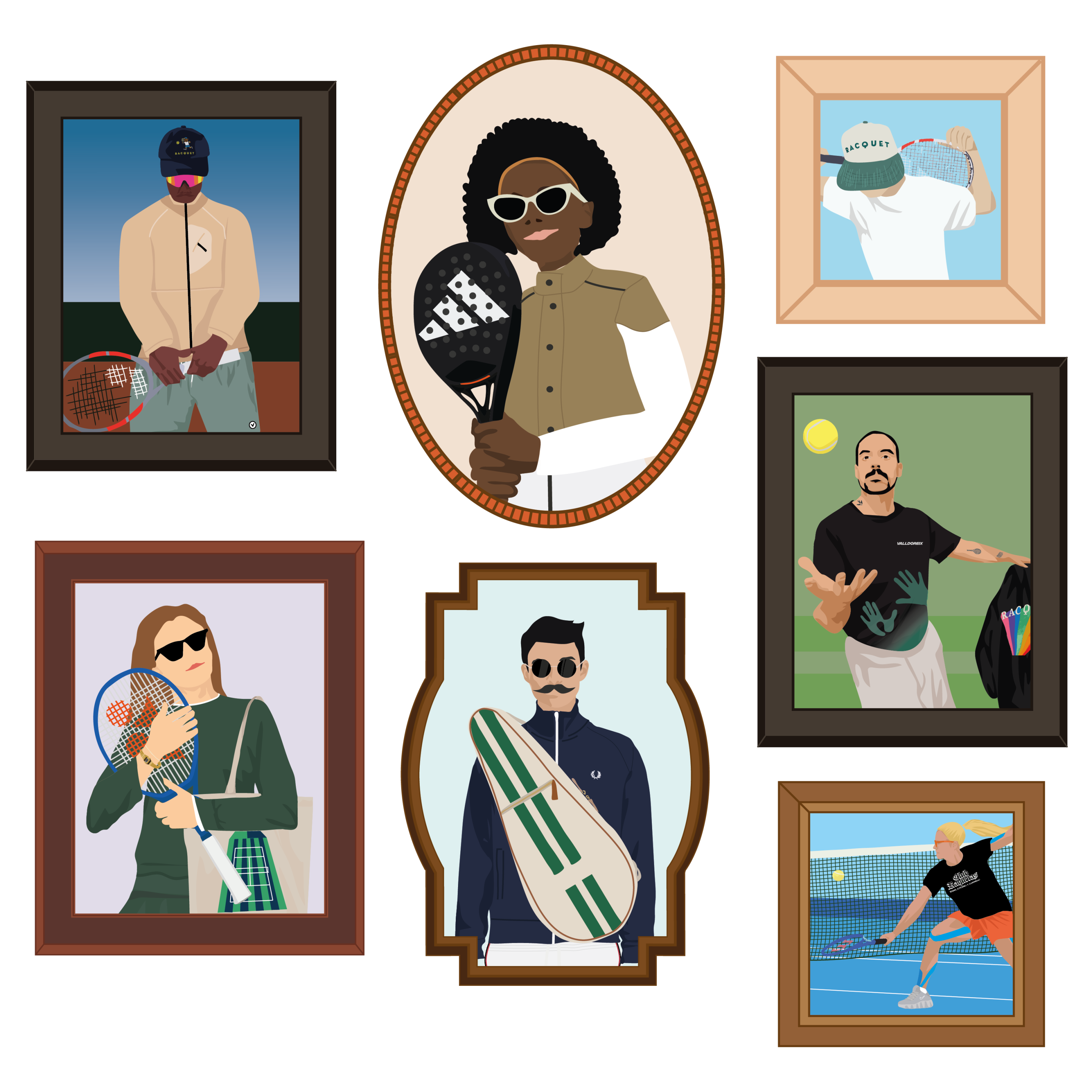For Joe Lynskey, age 46, second-youngest of twelve children, reality cleaved in two on the last afternoon of the year, in 2024, at the top of the 18th Street entrance to the #1 subway line in New York City. This is where Joe stopped and paused to think about what he wanted to do. It took about five or six seconds, a series of blinks, for him to make up his mind. To start and then finish deliberating over whether he should walk an additional four blocks to catch the express train, the one he’d ridden from his apartment earlier that day, or take the local here, and then make the transfer at 14th Street. The choice he made, the single strand of thought he followed, peeled from the universe of a billion other thoughts he’d already had, might have amounted to nothing. Instead, it opened a portal to another dimension of his existence.
Joe decided to make a run for it. He double-timed down the stairs and could hear the train approaching when he swiped in at the turnstile. He could see its headlights beaming down the tunnel from where he was standing on the platform, waiting to board.
In the other timeline, a fictional deviation constructed in Joe’s mind through replays and what-ifs and might-have-beens, he opted for the express train and the extra four-block stretch that came with it, even though it was cold, and even though it was raining. There, on the last afternoon of the year, in 2024, the heartbeat of his life continued just as it always had, pulsing evenly along before and after he stopped and paused at the top of the 18th Street entrance to the #1 subway line in New York City.
Instead, he took the stairs, walked onto the platform, and was pushed.
Joe’s knees buckled as his torso was propelled straight over his feet. On video—and there is video—he flails against nothing and takes a lurching dive right into the tracks. His legs are still sticking up in the air when the train arrives in frame. There is no less ghastly response than to say he should have been splattered. When he lands, his skull cracks. His spleen ruptures. The grainy security camera footage that caught the event makes it appear as though the train itself conjures a black hole, replete with its own gravitational pull. As though the hands against Joe’s back were mere interlopers, and the train’s invisible, inward force the thing that sucks him away from the platform before disappearing him instantly beneath it.
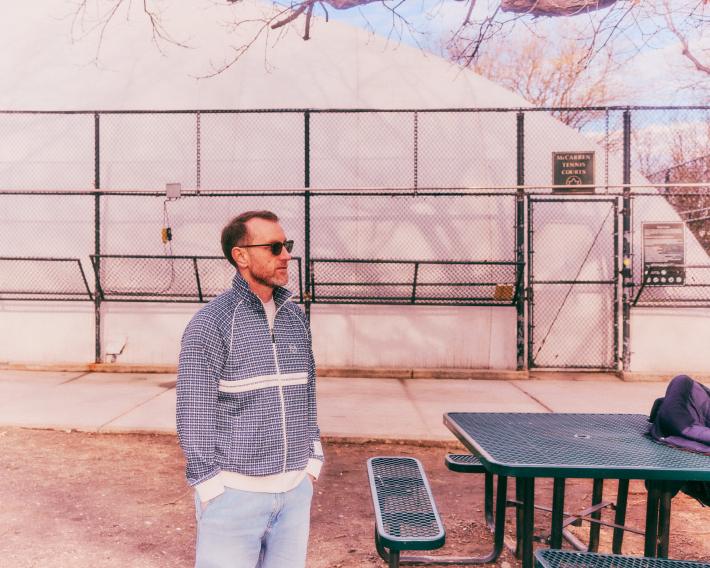
Joe’s life has wound through and around the tennis court. He was a closeted kid growing up in 1980s Miami, right at the height of the AIDS epidemic, and tennis was a singular refuge—a cerebral sport free from the truculent mob mentality plaguing the junior football leagues he wanted nothing to do with. Some of his earliest memories are of watching the greats on his television set: Jimmy Connors, John McEnroe; the women whose surnames were unnecessary—Billie Jean, Martina, Chrissy.
Even at the beginning, when his strokes were just goofy, aimless kid-strokes, he felt the game’s hypnosis: the way everything can disappear but the game; how your focus narrows to include only the ball and the whip of the racquet head. Where the laws of spin and pace and wind and sun collapse into the simplicity of just making contact, after which you are free; what happens next is beyond your control.
Joe realized quickly that a good day on court was euphoric and a bad one ruinous. When he was eight, Joe’s parents saw how enamored he was, and enrolled him in a tennis camp in Coral Gables. He played the way kids who love it play—uncontrollably, all-in—for years. He didn’t have to work hard to love it. The feeling swam to the surface all on its own.
When he was 13, Joe slipped and fell after leaving a match, and broke his ankle. He was stuck in a cast for months. The right joint, today, is still twice the size of the left. When he recounts this story now, he doesn’t directly connect the fracture to a larger breaking point in his life, but the timing of the injury lines up with a steep decline. By the time he was 14, the early fangs of addiction had already sunk into his neck, beginning with booze. He was lonely, isolated, even when he was partying. High school in ‘90s Florida was not a friendly place for a gay teen. By the time he graduated, he’d stopped playing tennis entirely. The literal storage of his racquet became a metaphorical shunt of his feelings. Drinking took up most of his time.
After two years of music school in Orlando, he moved to New York, in 2000, on Halloween, and spent the next hazy decade as a nightly fixture on the club scene, DJing and inhaling hard drugs. Occasionally when he came up for air, he’d pick up a racquet and hit with the same group of friends he drank with. He also had occasion to play tennis high on cocaine, which he does not recommend. “You want to talk about some erratic swings? Do a line of cocaine and put a racquet in your hand and try to hit a forehand.” He pauses when he tells me this, and shakes his head. “Cocaine is a disaster.”
For those who survive addiction, recovery stories have a kind of mythic familiarity. No one begins their transition gently. Joe kept drinking from the age of 14 until he was 33 because he didn’t want to quit. He stopped because he had to. His entire life had fallen apart; when he skidded into the early light of sobriety, he was broke, friendless, and estranged from his family.
When some of the initial sludge of a two-decade hangover cleared after 90 consecutive days of abstaining from drinking or using drugs, he allowed himself a $150 purchase with money he didn’t have: a garnet-red carbon fiber Volkl Team Tour. That was in January 2013. Over the course of the twelve subsequent years, through the day he was pushed in front of an oncoming subway train, relapsing never crossed his mind.
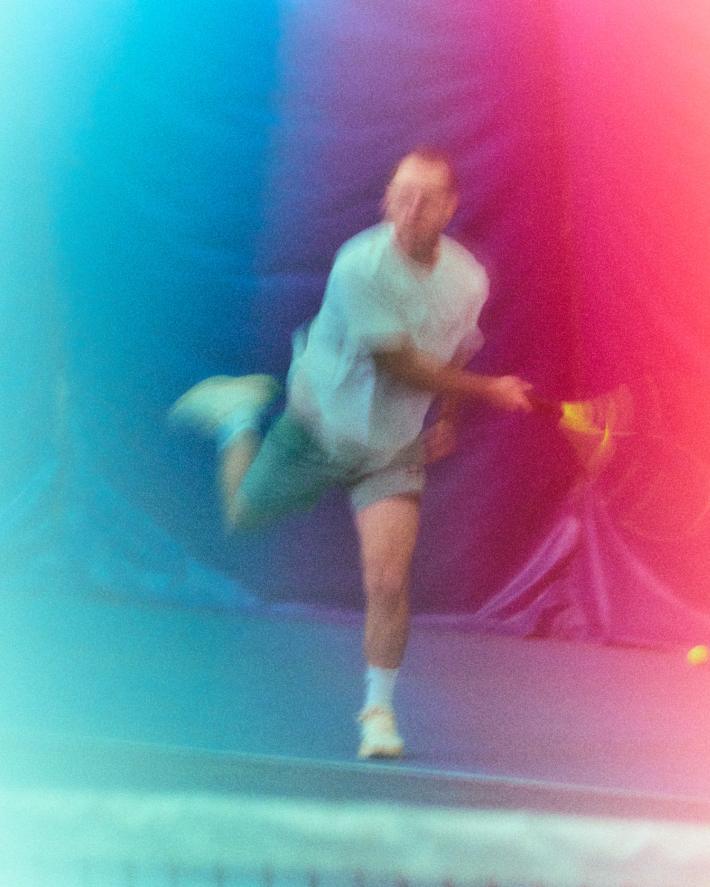
The steel leviathan of ten interlinked subway cars ground to a halt on top of Joe without actually touching him. However many specific inches the train loomed above his face, he couldn’t say. Only that the car he was trapped underneath was close—close enough for him to be able to make out an endless, rusted network of tubing, and to burn into his memory and nostrils the smell of a mechanical undercarriage, coated in filth.
During the seconds he was loose in space, after the push and before he landed on the tracks, Joe saw the face of the conductor through the window, who must have been shocked to see a flying, human object materialize in the path of the train. When Joe landed, he made a hard, perfect thud right between the rails. A thousand rehearsals of the same sequence could not have delivered a more uncanny position. He was alive, and his body was arranged like a left side-sleeper. Trash was everywhere. Fifteen seconds passed before he realized he could move at all. He let out a dull cry first.
When he felt his mind reconnect to his legs, he wiggled his feet on top of each other, to see if he was paralyzed. He lifted his head, to make sure he could turn it. He squeezed his fists. Beyond that, there was nowhere to go, except where he already was. The screaming began. Two full, excruciating minutes passed before a single person responded to him. Through the openings between the cars, he saw the opposite platform of the northbound train. He saw the ankles and feet of the people standing there, waiting to board. And he saw the third rail, electrified, directly in front of his face.
In a wink of the plot that will never be explained, two of the first firefighters on the scene had practiced rescuing people stuck under the train, or beside the train, the night before. He heard their voices first—loud, urgent—and then a flashlight shined in his face. Now he could see what he was actually laying in. The ground was wet. Every flavor of New York waste and excrement that exists rots in the tracks of the city’s subway system. Joe was covered in all of it. The crowd on both platforms began to swell. Bits of disembodied conversation reverberated around him. Don’t move. We’re coming to get you. Joe shouted his own name, and that he was in pain, and pleaded with them to hurry up. They responded to him and then talked about him, wondering out loud if he would stay awake, or if they thought they could move him at all.
He doesn’t know how the men who saved him descended onto the tracks; he just knows that he lifted his head again and there they were, army-crawling in his direction in bulky coats and orange helmets. He remembers the warmth of their faces. He remembers the startling, near-exquisite flood of relief he felt in not being alone anymore. Of having two other living beings next to him, speaking to him, in this darkened, grimy place.
“You know what that is?” they asked him, pointing to the third rail. It was like a quiz for children. Joe knew the answer. “Do not struggle. Do not move.” The next decision they had to make was whether they were going to pick Joe up by his arms, from a crouched position, or pull him by his feet. Four of Joe’s left ribs were broken. He didn’t want them to use his arms. A call was made to haul him by both feet and one arm to the first opening between the cars—the space used by subway surfers to pop in and out of a moving train. The distance to the opening was roughly the length of a body from Joe’s current location. Most importantly, it was also the point at which the third rail had a gap wide enough to maneuver him through.
The firefighters dragged Joe six feet forward, and then heaved him against the vertical cement face of the platform. He slumped like a rag doll against it. They needed him to lift his arms to get him onto the platform itself. They needed him to override the white-hot flash that ricocheted through his torso when he did, so they could finish pulling him up to safety. Ribs are easy enough to break, but the severity of the insult depends on the extent to which they split apart. With enough force, they shatter, heightening the risk that bony shrapnel might pierce nearby organs. The impact of Joe’s torso against steel tracks had sent tiny fragments of bone traveling through his interior, and it was a piece of loose rib that punctured his spleen. Blood pools outside of torn viscera quickly, and so as Joe had waited, in the dark, underneath the train, his own blood filled his abdominal cavity.
The scene came into focus at the same time he was lifted by his forearms. He was no longer under the train. People were screaming, and gasping, and filming him with their cellphones. There was a swarm of police, and more firefighters, and alarmed employees, and shell-shocked passengers, who could not believe that this slimy figure was being yanked from the belly of the subway car right in front of their very eyes, breathing, bleeding and talking. One of the first fully-formed sentences he made was about Leo, his 17-pound, 17-year-old Dachshund, who was resting at home. He wanted to make sure someone knew to take care of him.
The ride to the emergency room was a blur. Joe was awake, but confused. He spent the first five days of his weeklong stay in the ICU, the rhythms and sounds of the hospital now a soundtrack for the start of the new year. His backdrop was a blandly-hued palette of walls and hallways, dotted with beeps and dings and the garble of velcro pulling away from the blood pressure cuff.
Joe had a concussion, and a skull fracture. The bones of a human head are tough, and durable. The evolutionary structure of the cranium is by its nature designed to cocoon the neural mass within it. But the same blunt force that broke his ribs and knocked his brain against his skull was also strong enough to crack that skull open.
In the end, the leak in his spleen didn’t warrant a surgical repair. The little organ resolved on its own, and he got to keep it.
When Joe went to the fire station in February to meet his rescuers, and thank them, they told him they’d never pulled anyone out alive from underneath the train before. He was the first one.
Joe was a couple of years into his sobriety—around 2016—when he discovered the Metropolitan Tennis Group, a non-profit organization for LGBTQ+ tennis players in New York City. (“I did it by Googling ‘gay tennis New York.'") He was lonely still, despite having joined a supportive recovery community. His red Volkl Team Tour was collecting dust.
If there is a point in his journey through life on Earth that Joe sees as a spiritual homecoming, it’s when he found MTG. He hadn’t played group tennis since he was a child, but he decided to give it a try anyway. He doesn’t remember talking to many people the first time. What he does remember is that as he looked around and saw where he was—on court, with a bunch of gay people—he realized that this was how he was going to care for himself. This is what he was going to show up for. All of the clichés about being in the right place at the right time felt suddenly true.
The first time I meet Joe in-person, it is six weeks after he’d been pushed. It is late February in New York—cold, grey. At this time of year, outdoor courts are unplayable.
We’re in Fort Greene, Brooklyn, at a restaurant a few blocks from his apartment. By now, the press has devoured his story. He’s become used to answering intimate questions about his life while an interviewer records the conversation and scribbles frantically in a notebook. Tabloid paparazzi had staked out the hospital and tried to sneak into his room. Video of his push was on TikTok an hour after it happened. He watched it on his phone from the ICU.
He’s been going to the gym regularly, shaping his days around routines and repetitions that remind him he’s making progress: walking on the treadmill, stretching. Leo has remained nonplussed by his owner’s surreal turn of events; he lounges in the apartment and occasionally barks at nothing. Joe can’t pick up dumbbells, not yet, but he’s getting closer. He isn’t sleeping, though. He won’t anytime soon.
Shortly after his release from the hospital, remnants of the concussion began to impair Joe’s ability to see. He could read, but only the words he stared at directly on the page were legible. Surrounding paragraphs in his peripheral sight seemed to melt away. He started vision therapy, and spent hours in a small room, reading letters from a board on the wall and focusing and unfocusing his sight on inanimate objects. A kind of eye yoga, repeated over and over again. It helped. He bought a new pair of glasses to commemorate the improvement, and also because now he won’t be able to see a tennis ball without them. He’s still in concussion therapy—vestibular rehabilitation—to address his off-kilter balance. It’s all so fatiguing. Something that should be easy enough, like walking down a hallway and staring at fixed points on the floor, he explains, is frustrating because it isn’t.
But he thinks he might be ready to handle hitting a few balls. His ribs hurt. Playing tennis won’t be pain-free. A thing about ribs is that after they break, you can ice them, heat them, stretch them and temper the ache from the cracks with NSAIDs, but they will finish healing only when they are ready. When you move, they’ll move. You won’t notice them much until they hurt. But when they do, every time you breathe, or lift, or cough, or sit, they’ll announce their presence.
He’s nervous about how emotional it’s going to feel being back on the court after someone tried to take his life. He wants to do it anyway.
Other than Leo, tennis was the first thing on his mind in the hospital. Concussed and in crippling pain, he began to think of how, before he was pushed, he’d already paid for an Easter weekend at Total Tennis in Saugerties, New York, a year-round adult camp run out of an old Catskills resort. Total Tennis is the place where Joe’s buddies nicknamed his forehand “the rocket.” “My forehand is my weapon,” he says, and beams with pride. He loves to hit the ball hard. And even though it’s only been six weeks and he’s only just begun healing physically, to say nothing of the psychic trauma keeping him awake at night, he knows that in the end his limbs didn’t break and his life didn’t stop and he thinks there must be a reason for that; a reason deeper and more sacred than a random twist of the draw.
Because he still has perfect use of his legs, and his wrists, and his heart, he sees no reason why he can’t recuperate in time for his Total Tennis booking. The concussion didn’t permanently steal his vision and the broken ribs didn’t take his lungs. What he realized in the hospital is that if he began to orient his life, right now, and all the weeks and months to come from now, around mending the injuries he did have—serious but non-life threatening—then he would play at Total Tennis and he would play again after that, every chance he had for as long as he could.
Tennis is a siren song. Those who can will always return to it.
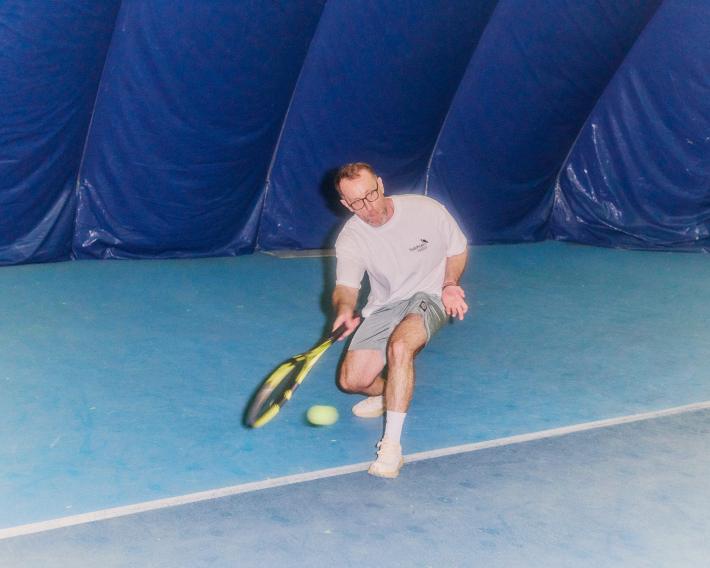
Two weeks later, Joe arranges to play with a friend, Matt, for his maiden voyage back to court. We gather just before 9 am on the first Saturday in March, at the McCarren Tennis Center in Brooklyn. This being indoor season in New York City, mountains have been moved and bribes offered to find them a court to hit on, and Joe is wearing a Certified Winners Club t-shirt and long shorts for the occasion. It is two months to the day since he was pushed in front of the train. Joe briefly squats to the ground. His knees are reluctant. “Oh God, I’m 45 and dying.”
As court time approaches, he begins pacing around the room, swinging his arms back and forth, and audibly exhaling. If he is thinking about the train, he doesn’t say it out loud. The nerves he’s feeling, the low grade thrums of uncertainty and anticipation that tennis always confers, are why he’s here.
Any return to court technically starts with a single shot—and Joe’s is a forehand, straight into the net. It seems to take a few cautious rallies for him to even realize he’s playing. That he is physically here at all, upright and swinging on a Saturday morning, when sixty days earlier he’d been bleeding from the head beneath a dirty subway car, is hard to make sense of. The session that unfolds over the next hour and a half between two loving friends is not a technical showstopper. None of the points will make it on to the proverbial highlight reel; there are no deep sprints or tweeners or banana shots or “how did he do that” cross-court no-look winners.
Neither Joe’s forehand nor his backhand loops much—his is a straight take-back, on both sides, eschewing flourishes for unapologetic efficiency. More McEnroe than Nadal. His footing is a little off, a little awkward, his movements not entirely sure, his vision adjusting to the dynamism of the play. He makes jokes when he hits errant moon-balls and broadcasts a playlist of exclamations—”ay yay yay!”—when he sends the ball into the net. But he plays like someone who loves it, to the bone.
There is one moment when he turns and walks to the baseline, unhurried, ponderous, that he looks like what he’s been through. Maybe it’s the pain of his ribs still healing, or the awareness that he’s being watched, but when he leans over for a ball, his posture—stooped, tired—looks imprinted, just briefly, with history. He suffered to get here. Not just during those eternal minutes in the dark underneath the train, unsure if he could move, unsure if he could walk, but through the years of life and pain and substance abuse before that. He stands back up, and the weight of the visual passes.
They take a few serves each. “I have missed this so much.”
At the one-hour mark, players for the next time slot begin trickling on to the neighboring courts. They arrive in hoodies, and parkas, and strip down once hitting gets underway. Matching sports bra and capri-legging sets, wrist guards, ankle wraps. The sounds of children’s clinics and doubles groups make for ambient noise. Joe and Matt decide to serve out a couple of games.
When their time is up, the score is 4-1, Lynskey. “Not bad,” he says.” He grins. “Not bad. Feeling fuckin’ great.”
Joe and I meet up again a few weeks later, now in the infancy of outdoor season, to talk ahead of a group clinic he wanted to try out. He’s tried playing twice since our last meeting; both efforts were thwarted by the weather. In a few days, he’ll head to Florida for a warmer climate and the $25 clinics at the Flamingo Park Tennis Center in Miami Beach.
His ribs, he estimates, are 85 percent healed. He can’t do push-ups and he gets chest pain when he lifts dumbbells. It hurts when he tries to sleep on his left side. He’s back to jumping rope at the gym—which is how he trains for cardio, for tennis—and riding a Citi Bike. His newly reacquired abilities make him feel like parts of his life are slowly coming back to him. He hasn’t made it to the subway yet. He doesn’t know when he will.
He mentions his legs. He still can’t believe they weren’t hanging over the tracks when the train rolled in. Or his arms, how they remained neatly tucked by his side. And his luck—that even as he lay there on top of four broken ribs, still as could be, screaming when he could, an errant twitch didn’t do him in. That the layers of black subway gunk and a deep, unavoidable stench of urine didn’t bake onto his skin when the third rail fried him to death. He doesn’t want to think about any of the nauseating circumstances of what could have been. All of the worst-case scenarios run on a loop in his mind anyway.
“How am I alive?” he asks. He asks this all the time. The first weeks of recovery were so stuffed with doctors’ appointments and messages from loved ones and requests for media interviews that there was very little silence. The reflection he does have time for now makes him tired.
On one of his Citi Bike rides, he saw a train rolling past him over a nearby bridge. He doesn’t know how much a subway car weighs (maybe a couple dozen tons) but the metaphorical weight of the car, when he thinks about it, feels shocking: the idea that he, Joe, a 5’9” flesh-and-blood human being, was trapped underneath it. Sometimes he imagines he’s still there, with a metal enclosure over his body. A coffin would feel the same.
I watch Joe play tennis one last time on a dreary mid-April day at the Manhattan Plaza Tennis Club, an indoor facility in Midtown. A television in the lobby is showing the Monte Carlo Open semifinal; Lorenzo Musetti and Alex DeMinaur are locked in a third-set tiebreak. We agree that Musetti’s recent, shorter haircut is working for him.
On court, the language of Joe’s upper body has softened considerably since the first balls he thwacked back in March. During a break, he tells me his ribs no longer hurt when he swings his racquet, and he is jubilant because Total Tennis awaits him the following weekend.
The instructor at Total Tennis weekend warns Joe on the first day that he’s holding his racquet too tight. Maybe from excitement, maybe from stress, but either way he’s got a death-grip he doesn’t let go of for the entire 48 hours. The weather is beautiful. Joe sends me a few photos from the camp, which is set in the base of the Catskill Mountains and looks like a cross between the sets from Dirty Dancing and Wet Hot American Summer. Blue hard courts make for a stunning contrast against a cerulean sky. Joe’s delight is palpable, even in his texts, but later he’ll admit that he felt the irritation in the tendons surrounding his right elbow almost immediately after the first hitting session. He played with it all the way through the final round of King of the Court, on Sunday afternoon. He was playing terribly. He couldn’t get over to the other side of the court—the King side, reserved for winners—and kept knocking balls into the net, one unforced error after the other. But then, finally, he locked in. Two scored points launched him to the defending King position and once he was there, he couldn’t miss. The coach started clapping and counting his score out loud as it ticked up. The whoops of his court mates cheered him on.
“This is why I love tennis. It puts me in a place where I can be clear-headed and just smack the ball.” He says this on a bench in Fort Greene, in front of the tennis courts near his apartment as he recounts the weekend. It’s early May, temperatures have climbed to sweltering levels, and we’re seated directly in the sun. Somewhere, a toddler is screaming.
He tells me about how he moved into his apartment last August, four months before the push. The timing feels serendipitous, he says. He just happened to move into the first place he saw in Brooklyn, after 21 years as a Manhattanite, and that place happened to be within walking distance of a row of gorgeous courts. He waves his hand in the air a little bit when he explains this.
The other timelines—the ones that might have instigated and then spidered off into their own, complicated webs had he chosen a different apartment, or the express train over the local, or dropped his wallet when he swiped in at the turnstile, or waited on the bench instead of the platform edge—have collapsed into this one, the only one. The one where he had enough time during the winter to heal for his reservation at Total Tennis. Where the exact right number of milliseconds separated the front of the #1 train from the bottom of his legs. Where thirteen years of sobriety have flushed his brain with gratitude for what he still has and can do, instead of drowning him in the vileness of the thing that happened. Timing doesn’t work out for everyone; 10 people were murdered in the New York City subway in 2024. But, somehow, it did for Joe.
He still isn’t sleeping well. The first thing he sees when he wakes up from nightmares and then tries to close his eyes is himself under the tracks. Not everything he was excited about on the morning of December 31, 2024, brings him the same kind of joy it did then. He isn’t socializing as much. He isn’t making music. But he still wants to get up and hit in the morning, and figure out his summer court schedule and keep icing his elbow, because he thinks he has tennis elbow for the very first time in his life.
A few weeks later he texts me an update from physical therapy. He hasn’t been able to play tennis again since the Catskills because, as it happens, the thing he developed from over-squeezing his racquet at Total Tennis is actually called “golfer’s elbow,” which he finds amusing. In a way, it’s fitting. Tennis has not betrayed him.
Caira Conner is a writer based in New York. Her work has appeared in New York Magazine, The Atlantic, Esquire, The New York Times, and elsewhere. She was a walk-on D3 singles player, and quit four days into her first and final season.
